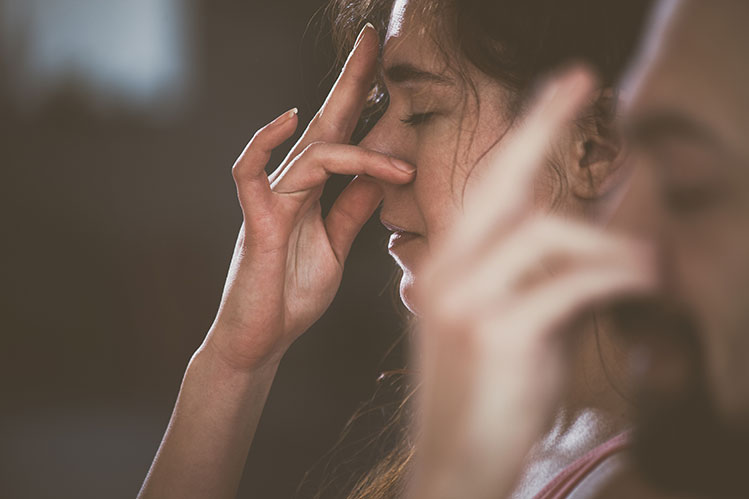The main program consists of three audio MP3 tracks. These audio tracks are created using brainwave-synchronization technology audio that speaks directly to your subconscious, to help you eliminate limiting beliefs.

It’s obvious that breathing is essential to stay alive.
We don’t even need to think about. We’re designed to do it automatically.
And because we don’t really need to think about it,
most of us breathe improperly and insufficiently.
Chest breathing, which is how most people breathe,
is designed to happen when we feel danger.
Our heart rate increases, muscles tense, and we begin breathing rapidly.
Proper breathing, diaphragmatic breathing,
delivers greater oxygen to red blood cells,
some of which can be cut off during chest breathing,
and releases carbon dioxide, keeping it in the right balance with oxygen.
Learn the basics first. Inhale slowly through the nose
by first filling the diaphragm then the top of the lungs.
Exhale very slowly through the nose, fully forcing stale
air out at the bottom of the breath and using the full capacity of your lungs.
If you want to know if you’re breathing properly,
place one hand on your chest and the other on your upper abdomen.
As you breathe, see which hand rises more than the other.
Ujjayi (pronounced oo-jai), commonly translated as victorious breath,
is an ancient breathing technique that has a balancing influence on
the entire cardiorespiratory system and releases feelings of irritation and frustration.
It helps calm the mind and body and concentrates and
directs breath to the area you focus on, giving it extra power.
Ujjaya stretches out the duration of the breath cycle by using the
back of the throat like a pressure value to regulate the flow of air.
You must learn to remain relaxed and open without
rushing to gulp the next inhalation. Go slow and steady.
Try shifting into Ujjayi breath whenever you
find yourself becoming aggravated or stressed,
and you should notice a prompt soothing effect.
Focusing on Ujjayi breathing will help you stay centered.
Ujjayi is also useful when you’re doing aerobic exercise such
as running or cycling to improve respiratory efficiency.
Experiment with this breathing technique when you are
working out and see if your body and respiration work more efficiently.
This technique calms the body and helps the mind focus.
If you are doing a Nei Gong or Tai Chi exercise, match the length of your inhale and exhale to the length of the movement. The length of each may change, but keep the inhale, exhale, and duration of the movement equal to each other.
This technique brings attention to the present
moment and helps to calm and ground the mind.
Continue for 10 breaths during breathing practice,
then adjust to match any movements you are engaging in.
Many people have chests that are constricted from
poor posture and a lifetime of insufficient breathing.
They simply cannot relax their lungs enough to bring in more breath.
If you have trouble with expanding your chest and diaphragm,
do 3-Part Breath while lying on your back on the floor.
This method is traditionally thought to balance the two sides of your brain and to clear the nadis,
which are energy channels that run along the base of the spine to the crown of the head.
Research has shown that this breath can reduce blood pressure.
If you are congested, expect this pranayama to move the mucus out.
At any given moment, one nostril is more open than the other.
Your pituitary gland, which is considered to be the master gland,
serves as the thermostat to control this.
The body generally switches between nostrils every 2 1/2 hours.
You might only make it through a few rounds of this breath.
Work up to doing 10 rounds.
You can also take a break and then resume the exercise.
If you ever begin to feel light-headed,
release both nostrils and breathe normally.
This technique soothes and cools the spine in
the area of the fourth, fifth and sixth vertebrae.
This in turn regulates sexual and digestive energy.
This breath is often used for lowering fever and cooling off anger.
It rejuvenates and detoxifies when practiced regularly.
Fifty-two cooling breaths a day are recommended to increase life span.
If you have difficulty rolling the sides of the tongue inward, fold them in as much as possible.
This technique is cleansing, invigorating, and warming. It consists of rapid, forced exhales followed by passive inhales.
You will visualize this prana as light-energy entering you as you inhale.
The focal point of Breath of Fire is at the navel.
The breath is rapid (2-3 breaths per second)
and is continuous and powerful with no pause
between inhalation and exhalation.
You will not hyperventilate as long as you do not use the upper chest.
Breath of Fire cleanses the blood, the mucous linings of the lungs and all cells.
It expands lung capacity, strengthens nerves, warms the body, and activates the brain.
It may be helpful at first to put the hand on
the abdomen to feel the inward pull and relaxation.
Although this is a very balanced breath with no emphasis on the exhale or inhale,
focus primarily on the exhalation, which will create the sound of a steam engine.
The average learner will achieve 2 breaths per second. If this is too much for you, do just one accurate breath per second. The key to Breath of Fire is to not engage the upper chest in the exercise.